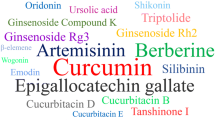Abstract
No traditional Japanese and Chinese herbal preparations have been shown to be effective antitumor agents, and a Japanese herbal therapy (Kampo medicine) for cancer that causes fewer adverse drug reactions than orthodox pharmaceuticals is desired. Our present study demonstrated that a Kampo preparation Daikenchuto (DKT) exerts an antitumor effect against various cancer cells. We also discovered an antitumor factor in Japanese Zanthoxylum peel, which is an ingredient of DKT. Breast, esophageal, gastric, and colon cancer cell lines were individually incubated with DKT for 1–72 h, followed by assessment of tumor growth inhibition by MTT assay. The cancer cells were also analyzed for apoptotic changes after DKT treatment. Nude mice were used to establish a model of gastric cancer tumor growth and peritoneal disseminated metastasis, in which the number of peritoneal disseminations was evaluated after oral administration of DKT for 4 weeks. In addition, the antitumor effects of the individual DKT ingredients (viz., ginseng, Japanese Zanthoxylum peel, and processed ginger) and other Kampo preparations were also analyzed. The antitumor effect of DKT was demonstrated in gastric, breast, esophageal, and colon cancer cells. DKT treatment induced apoptosis in these cells. Oral administration of DKT had a tendency to reduce the growth and significantly reduced the peritoneal dissemination of gastric cancer in the nude mouse model compared with control. DKT exhibited a higher antitumor effect than other Kampo preparations. Furthermore, Japanese Zanthoxylum peel, an ingredient of DKT, showed a particularly potent antitumor effect. Our study indicated that DKT is useful as a Kampo preparation for cancer therapy. We also showed that Japanese Zanthoxylum peel, an ingredient of DKT, contains an antitumor factor.





Similar content being viewed by others
References
Cancer statistics and graph database (2014) Center for the cancer control and information services. http://ganjoho.jp/public/statistics/backnumber/_jp.html
Fujiki K et al (2008) IL-12 and IL-18 induction and subsequent NKT activation effects of the Japanese botanical medicine Juzentaihoto. Int J Mol Sci 9(7):1142–1155
Ishikawa S et al (2012) Suppressive effect of juzentaihoto on vascularization induced by b16 melanoma cells in vitro and in vivo. Evid Based Complement Altern Med 2012:945714. doi:10.1155/2012/945714
Takegawa Y et al (2008) Can Kampo therapy prolong the life of cancer patients? J Med Invest 55(1–2):99–105
Shu X et al (2005) Chinese herbal medicine and chemotherapy in the treatment of hepatocellular carcinoma: a meta-analysis of randomized controlled trials. Integr Cancer Ther 4(3):219–229
Iwanaga T (2012) Is it possible to treat the cancer with “Kampo Medicine”? Cancer Hum 39(5):20–31 (Article in Japanese)
Oka H et al (1995) Prospective study of chemoprevention of hepatocellular carcinoma with Sho-saiko-to (TJ-9). Cancer 76(5):734–749
Saiki I (2000) A Kampo medicine “Juzen-taiho-to” - prevention of malignant progression and metastasis of tumor cells and the mechanism of action. Biol Pharm Bull 23(6):677–688
Kono T, Kanematsu T, Kitajima M (2009) Exodus of Kampo, traditional Japanese medicine, from the complementary and alternative medicines: is it time yet? Surgery 146(5):837–840
Shibata C et al (1999) The herbal medicine Dai-Kenchu-Tou stimulates upper gut motility through cholinergic and 5-hydroxytryptamine 3 receptors in conscious dogs. Surgery 126(5):918–924
Nagano T, Itoh H, Takeyama M (1999) Effect of Dai-kenchu-to on levels of 3 brain-gut peptides (motilin, gastrin and somatostatin) in human plasma. Biol Pharm Bull 22(10):1131–1133
Satoh K et al (2001) Mechanism of atropine-resistant contraction induced by Dai-kenchu-to in guinea pig ileum. Jpn J Pharmacol 86(1):32–37
Kono T et al (2008) Colonic vascular conductance increased by Daikenchuto via calcitonin gene-related peptide and receptor-activity modifying protein 1. J Surg Res 150(1):78–84
Komatsu K et al (1995) Pharmacognostical Studies on the Sino-Japanese Crude Drugs “Huajiao” and “Sansho”. Nat Med 49(3):137–147 (Article in Japanese)
Hirokawa Y et al (2006) Sichan pepper extracts block the PAK1/cyclin D1 pathway and the growth of NF1-deficient cancer xenograft in mice. Cancer Biol Ther 5(3):305–309
Yang Y et al (2006) Zanthoxyli Fructus induces growth arrest and apoptosis of LNCaP human prostate cancer cells in vitro and in vivo in association with blockade of the AKT and AR signal pathways. Oncol Rep 15(6):1581–1590
Acknowledgments
This work was partly supported by JSPS KAKENHI Grant Number 15H05268.
Author information
Authors and Affiliations
Corresponding author
Rights and permissions
About this article
Cite this article
Nagata, T., Toume, K., Long, L.X. et al. Anticancer effect of a Kampo preparation Daikenchuto. J Nat Med 70, 627–633 (2016). https://doi.org/10.1007/s11418-016-0989-x
Received:
Accepted:
Published:
Issue Date:
DOI: https://doi.org/10.1007/s11418-016-0989-x




